Upper GI and small bowel series
An upper GI and small bowel series is a set of x-rays taken to examine the esophagus, stomach, and small intestine.
x-rays
X-rays are a type of electromagnetic radiation, just like visible light. An x-ray machine sends individual x-ray waves through the body. The images...

Barium enema is a different test that examines the large intestine.
Barium enema
Barium enema is a special x-ray of the large intestine, which includes the colon and rectum.

How the Test is Performed
An upper GI and small bowel series is done in a radiology department.
You may get an injection of a medicine that slows muscle movement in the small intestine. This makes it easier to see the structures of your organs on the x-rays.
Before the x-rays are taken, you must drink 16 to 20 ounces (480 to 600 milliliters) of a milkshake-like drink. The drink contains a substance called barium, which shows up well on x-rays.
An x-ray method called fluoroscopy tracks how the barium moves through your esophagus, stomach, and small intestine. Pictures are taken while you sit or stand in different positions.
The test most often takes around 3 hours but can take as long as 6 hours to complete.
A GI series may include this test or a barium enema.
How to Prepare for the Test
You may have to change your diet for 2 or 3 days before the test. In most cases, you will not be able to eat for a period of time before the test.
Be sure to ask your health care provider if you need to change how you take any of your medicines. Often you can continue taking the medicines you take by mouth. Never make any changes in your medicines without first talking to your provider.
You will be asked to remove all jewelry on your neck, chest, or abdomen before the test.
How the Test will Feel
This test may cause mild bloating but no discomfort most of the time. The barium milkshake feels chalky as you drink it.
Why the Test is Performed
This test is done to look for a problem in the structure or function of your esophagus, stomach, or small intestine.
Normal Results
A normal result shows that the esophagus, stomach, and small intestine are normal in size, shape, and movement.
A normal result may vary depending on your overall health. Talk to your provider about the meaning of your specific test results.
What Abnormal Results Mean
Abnormal results in the esophagus may indicate the following problems:
- Achalasia
Achalasia
The tube that carries food from the mouth to the stomach is the esophagus or food pipe. Achalasia makes it harder for the esophagus to move food int...
 ImageRead Article Now Book Mark Article
ImageRead Article Now Book Mark Article - Diverticula
Diverticula
Diverticula are small, bulging sacs or pouches that form on the inner wall of the intestine. Diverticulitis occurs when these pouches become inflame...
 ImageRead Article Now Book Mark Article
ImageRead Article Now Book Mark Article - Esophageal cancer
Esophageal cancer
Esophageal cancer is cancer that starts in the esophagus. This is the tube through which food moves from the mouth to the stomach.
 ImageRead Article Now Book Mark Article
ImageRead Article Now Book Mark Article - Esophageal narrowing (stricture) - benign
Esophageal narrowing (stricture) - beni...
Benign esophageal stricture is a narrowing of the esophagus (the tube from the mouth to the stomach). It causes swallowing difficulties. Benign mean...
Read Article Now Book Mark Article - Hiatal hernia
Hiatal hernia
Hiatal hernia is a condition in which part of the stomach extends through an opening of the diaphragm into the chest. The diaphragm is the sheet of ...
 ImageRead Article Now Book Mark Article
ImageRead Article Now Book Mark Article - Ulcers
Ulcers
An ulcer is a crater-like sore on the skin or mucous membrane. Ulcers form when the top layers of skin or tissue have been removed. They can occur ...
 ImageRead Article Now Book Mark Article
ImageRead Article Now Book Mark Article
Abnormal results in the stomach may indicate the following problems:
- Gastric cancer
Gastric cancer
Stomach cancer is cancer that starts in the stomach.
 ImageRead Article Now Book Mark Article
ImageRead Article Now Book Mark Article - Gastric ulcer - benign
Gastric ulcer
A peptic ulcer is an open sore or raw area in the lining of the stomach or intestine. There are two types of peptic ulcers:Gastric ulcer -- occurs in...
 ImageRead Article Now Book Mark Article
ImageRead Article Now Book Mark Article - Gastritis
Gastritis
Gastritis occurs when the lining of the stomach becomes inflamed or swollen. Gastritis may last for only a short time (acute gastritis) or it may lin...
 ImageRead Article Now Book Mark Article
ImageRead Article Now Book Mark Article - Polyps (a tumor that is usually noncancerous and grows on the mucus membrane)
Mucus membrane
Mucosa is moist tissue that lines certain parts of the inside of your body. It is in your: NoseMouthLungsDigestive tractUrinary and genital tracts G...
 ImageRead Article Now Book Mark Article
ImageRead Article Now Book Mark Article - Pyloric stenosis (narrowing)
Pyloric stenosis
Pyloric stenosis is a narrowing of the opening from the stomach into the small intestine. This is called the pylorus. This article describes the co...
 ImageRead Article Now Book Mark Article
ImageRead Article Now Book Mark Article
Abnormal results in the small intestine may indicate the following problems:
- Diverticulosis
- Malabsorption syndrome
Malabsorption syndrome
Malabsorption involves problems with the body's ability to take in (absorb) nutrients from food.
 ImageRead Article Now Book Mark Article
ImageRead Article Now Book Mark Article - Narrowing (stricture)
- Swelling and irritation (inflammation) of the small intestines
- Tumors
- Ulcers
The test may also be done for the following conditions:
- Annular pancreas
Annular pancreas
An annular pancreas is a ring of pancreatic tissue that encircles the duodenum (the first part of the small intestine). The normal position of the p...
 ImageRead Article Now Book Mark Article
ImageRead Article Now Book Mark Article - Duodenal ulcer
Duodenal ulcer
A peptic ulcer is an open sore or raw area in the lining of the stomach or intestine. There are two types of peptic ulcers:Gastric ulcer -- occurs in...
 ImageRead Article Now Book Mark Article
ImageRead Article Now Book Mark Article - Gastroesophageal reflux disease
Gastroesophageal reflux disease
Gastroesophageal reflux disease (GERD) is a condition in which the stomach contents leak backward from the stomach into the esophagus (food pipe). F...
 ImageRead Article Now Book Mark Article
ImageRead Article Now Book Mark Article - Gastroparesis
Gastroparesis
Gastroparesis is a condition that reduces the ability of the stomach to empty its solid contents. It does not involve a blockage (obstruction) of th...
 ImageRead Article Now Book Mark Article
ImageRead Article Now Book Mark Article - Intestinal obstruction
Intestinal obstruction
Intestinal obstruction is a partial or complete blockage of the bowel. The contents of the intestine cannot pass through it.
 ImageRead Article Now Book Mark Article
ImageRead Article Now Book Mark Article - Lower esophageal ring
Lower esophageal ring
A lower esophageal ring is an abnormal ring of tissue that forms where the esophagus (the tube from the mouth to the stomach) and stomach meet....
 ImageRead Article Now Book Mark Article
ImageRead Article Now Book Mark Article - Primary or idiopathic intestinal pseudo-obstruction
Primary or idiopathic intestinal pseudo...
Intestinal pseudo-obstruction is a condition in which there are symptoms of blockage of the intestine (bowels) without any physical blockage....
 ImageRead Article Now Book Mark Article
ImageRead Article Now Book Mark Article
Risks
You are exposed to a low level of radiation during this test, which carries a very small risk for cancer. X-rays are monitored and regulated to provide the minimum amount of radiation exposure needed to produce the image. Most experts feel that the risk is low compared with the benefits.
Pregnant women should not have this test in most cases. Children are more sensitive to the risks for x-rays.
Barium may cause constipation. Talk to your provider if the barium has not passed through your system by 2 or 3 days after the exam.
Considerations
After this test, the barium that remains in the body may block details in other imaging tests. For this reason, other imaging tests may be done first.
Reviewed By
Jenifer K. Lehrer, MD, Gastroenterologist, Philadelphia, PA. Review provided by VeriMed Healthcare Network. Also reviewed by David C. Dugdale, MD, Medical Director, Brenda Conaway, Editorial Director, and the A.D.A.M. Editorial team.
Agosto O, Dass C, Caroline DF. The stomach. In: Adam A, Dixon AK, Gillard JH, Schaefer-Prokop CM, eds. Grainger & Allison's Diagnostic Radiology. 7th ed. Philadelphia, PA: Elsevier; 2021:chap 20.
Al Sarraf AA, McLaughlin PD, Maher MM. The small intestine, mesentery and peritoneal cavity. In: Adam A, Dixon AK, Gillard JH, Schaefer-Prokop CM, eds. Grainger & Allison's Diagnostic Radiology. 7th ed. Philadelphia, PA: Elsevier; 2021:chap 21.
Carucci LR. Diagnostic imaging procedures in gastroenterology. In: Goldman L, Cooney KA, eds. Goldman-Cecil Medicine. 27th ed. Philadelphia, PA: Elsevier; 2024:chap 119.
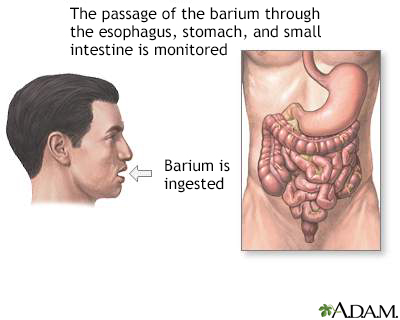
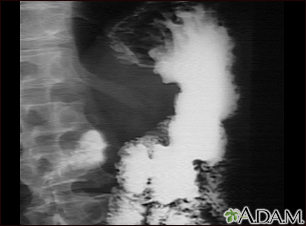
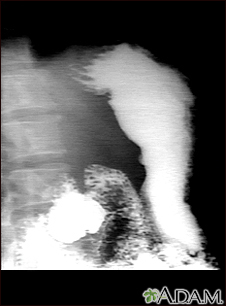
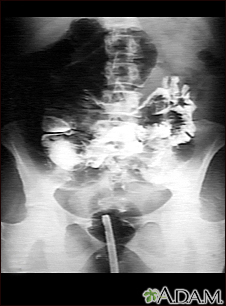
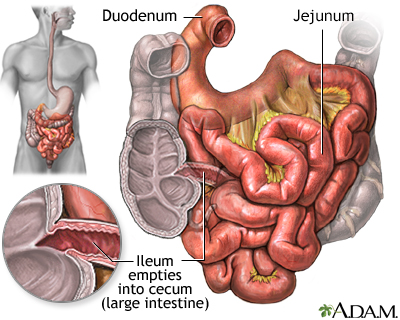
 All rights reserved.
All rights reserved.